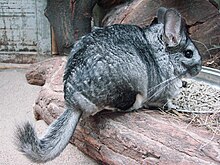| Chinchillas | |
|---|---|

| |
| Chinchilla lanigera at the Wrocław Zoo in Poland | |
| Scientific classification | |
| Domain: | Eukaryota |
| Kingdom: | Animalia |
| Phylum: | Chordata |
| Class: | Mammalia |
| Order: | Rodentia |
| Family: | Chinchillidae |
| Subfamily: | Chinchillinae |
| Genus: | Chinchilla Bennett, 1829 |
| Type species | |
| Chinchilla lanigera[3] Bennett, 1829
| |
| Species[1][2] | |

| |
| Range of C. lanigera and C. chinchilla.
C. chinchilla
C. lanigera
| |
Chinchillas are either of two species (Chinchilla chinchilla and Chinchilla lanigera)[4] of crepuscular rodents of the parvorder Caviomorpha, and are native to the Andes mountains in South America.[5] They live in colonies called "herds" at high elevations up to 4,270 m (14,000 ft). Historically, chinchillas lived in an area that included parts of Bolivia, Peru and Chile, but today, colonies in the wild are known only in Chile.[6] Along with their relatives, viscachas, they make up the family Chinchillidae. They are also related to the chinchilla rat.
The chinchilla has the densest fur of all extant terrestrial mammals, with around 20,000 hairs per square centimeter and 50 hairs growing from each follicle.[7] The chinchilla is named after the Chincha people of the Andes, who once wore its dense, velvet-like fur and ate their meat.[8] By the end of the 19th century, chinchillas had become quite rare after being hunted for their notably soft fur. Most chinchillas currently used by the fur industry for clothing and other accessories are farm-raised.[9] Domestic chinchillas descended from C. lanigera are sometimes kept as pets, and may be considered a type of pocket pet.
- ^ Roach, N.; Kennerley, R. (2016). "Chinchilla chinchilla". IUCN Red List of Threatened Species. 2016: e.T4651A22191157. doi:10.2305/IUCN.UK.2016-2.RLTS.T4651A22191157.en.
- ^ Woods, C. A. and Kilpatrick, C. W. (2005). Infraorder Hystricognathi. In: D. E. Wilson and D. M. Reeder (eds), Mammal Species of the World, pp. 1538–1599. The Johns Hopkins University Press, Baltimore, MD, USA. ISBN 9780801882210
- ^ Wilson, D. E.; Reeder, D. M., eds. (2005). Mammal Species of the World: A Taxonomic and Geographic Reference (3rd ed.). Johns Hopkins University Press. ISBN 978-0-8018-8221-0. OCLC 62265494.
- ^ "Chinchilla". Integrated Taxonomic Information System. Retrieved 2022-09-05.
- ^ Chisholm, Hugh, ed. (1911). . Encyclopædia Britannica. Vol. 6 (11th ed.). Cambridge University Press. p. 232.
- ^ Patton, James L.; Pardiñas, Ulyses F. J.; D'Elía, Guillermo (2015). Rodents. Mammals of South America. Vol. 2. University of Chicago Press. pp. 765–768. ISBN 9780226169576.
- ^ "Chinchilla History and Care Recommendations". MedVet. 3 December 2016. Retrieved 24 November 2023.
- ^ "What Is A Chinchilla?". Davidson Chinchillas. Archived from the original on 2012-05-27. Retrieved 2008-02-01.
- ^ Jiménez, Jaime E. (1996). "The extirpation and current status of wild chinchillas Chinchilla lanigera and C. brevicaudata" (PDF). Biological Conservation. 77 (1): 1–6. Bibcode:1996BCons..77....1J. doi:10.1016/0006-3207(95)00116-6. Archived from the original (PDF) on 2019-07-10. Retrieved 2007-04-16.